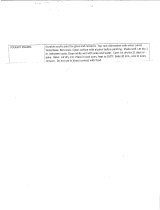
5
Warnings & Safety
WARNING
DO NOT use commercial oven cleaners inside the oven.
Use of these cleaners can produce hazardous fumes or
can damage the porcelain nishes.
WARNING
DO NOT cook on the oven bottom. The could result in
damage to your appliance. Always use oven racks when
cooking in the oven.
WARNING
To prevent possible damage to cabinets and cabinet
nishes, use only materials and nishes that will not
discolor or delaminate and will withstand temperatures
up to 194°F (90°C). Heat and moisture resistant adhesive
must be used if the product is to be installed in laminated
cabinetry. Check with your builder or cabinet supplier to
make sure that the materials meet these requirements.
CAUTION
This appliance is not to be used by persons (including
children) with reduced physical, sensory or mental
capabilities, or lack of experience and knowledge, unless
they have been given supervision or instruction concerning
the use of the appliance by a person responsible for their
safety. Children should be supervised to ensure that they do
not play with the appliance.
WARNING
This appliance features a self-cleaning cycle. During this
cycle, the oven reaches elevated temperatures in order to
burn o soil and deposits. A powder ash residue is left in the
bottom of the oven after completion of the self-clean cycle.
Note: DO NOT use commercial oven cleaners inside the
oven. Use of these cleaners can produce hazardous fumes
or can damage the porcelain nishes. DO NOT line the
oven with aluminum foil or other materials. These items can
melt or burn during a self-clean cycle, causing permanent
damage to the oven.
CAUTION
BURN HAZARD
The oven door, especially the glass, can get
hot. Danger of burning: DO NOT touch the
glass!
WARNING
BURN OR ELECTRICAL SHOCK HAZARD
Make sure all controls are OFF and drawer is
COOL before cleaning. Failure to do so can
result in burns or electrical shock.
WARNING
ELECTRICAL SHOCK HAZARD
Disconnect the electric power at the main fuse
or circuit breaker before replacing bulb.
WARNING
BURN HAZARD
When self-cleaning, surfaces may get hotter
than usual. Therefore, children should be kept
away.
WARNING
DO NOT touch the exterior portions of the oven
after self-cleaning cycle has begun, since some
parts become extremely hot to the touch!
During the rst few times the self-cleaning feature is used,
there may be some odor and smoking from the “curing” of
the binder in the high- density insulation used in the oven.
When the insulation is thoroughly cured, this odor will
disappear. During subsequent self-cleaning cycles, you may
sense an odor characteristic of high temperatures.
KEEP THE KITCHEN WELL-VENTED DURING THE
SELF-CLEAN CYCLE.
NOTICE
Avoid any damage to oven vents. The vents need to be
unobstructed and open to provide proper air ow for
optimal oven performance.
WARNING
STATE OF CALIFORNIA PROP 65
The California Safe Drinking Water and Toxic Enforcement
Act requires the Governor of California to publish a list of
substances known to the state to cause cancer, birth defects
or other reporductive harm and requires busineses to warn
customers of potential exposure to such substances.
Self-clean ovens can cause low-level exposure to some of
these substances, including carbon monoxide, during the
cleaning cycle. Exposure can be minimized by venting with
an open window or using a ventilation fan or hood




















